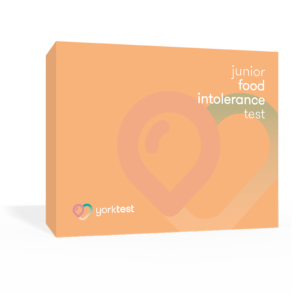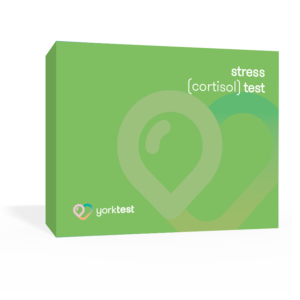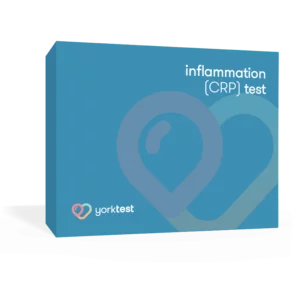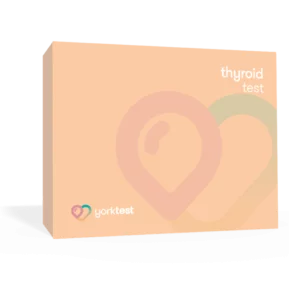- What is lactose intolerance?
- How is lactose intolerance caused?
- What are the symptoms of lactose intolerance in toddlers?
- What is dairy intolerance?
- What are the symptoms of dairy intolerance in toddlers?
- What should I do if I think my child has a dairy or lactose intolerance?
- What next?
- Optimise your child’s health with Yorktest’s Junior Food Intolerance Test
Amidst the terrible twos, growing pains, common illnesses and general mishaps common with toddlers, spotting the symptoms of lactose intolerance can be difficult. When you add dairy intolerance to the mix, which has many of the same signs, symptoms, and trigger foods as lactose intolerance, things can get even more confusing. To help out, we’ve put together a full guide to dairy and lactose intolerance, so you can find out exactly what’s troubling your toddler.
What is lactose intolerance?
Lactose is a naturally occurring sugar found in milk. Usually, when lactose is consumed, it is passed through the digestive system into the small intestine, where it is broken down by the enzyme lactase to be easily absorbed in the bloodstream.
However, some people don’t produce enough lactase, and thus when lactose is consumed the body finds it difficult to break down and absorb. This is called lactose intolerance. It’s estimated that around 5% of the UK’s population has some form of lactose sensitivity.
For people with this intolerance, lactose isn’t broken down in the small intestine, and instead passes through to the colon where it is broken down by bacteria. This process causes the production of fatty acids and gases, which for most people are the source of the uncomfortable symptoms of lactose intolerance.
How is lactose intolerance caused?
Whilst all lactose intolerances are caused by a lactase deficiency, this deficiency occurs for a number of reasons. As such, lactose intolerance is often broken down into two different types; primary and secondary.
Primary lactose intolerance is caused by a genetic inability to produce lactase. Usually, people with this type of lactose intolerance are able to make lactase up until around age two. After this age, lactase production gradually ceases, and lactose is no longer able to be broken down properly.
Secondary lactose intolerance isn’t genetic, is usually temporary, and in most cases is triggered by a problem with the small intestine. This could be due to another condition or illness, such as gastroenteritis or coeliac disease, or due to the medication a person is taking. Unlike primary, secondary lactose intolerance can usually be dealt with by treating the source illness, removing problem medications, diet management plans, or even lactase supplements.
What are the symptoms of lactose intolerance in toddlers?
The symptoms of both primary and secondary lactose intolerance are the same, and often start to show up in early childhood. We’ve outlined some of the most common signs your child might not be reacting well to lactose below.
- Wind
- Diarrhoea
- Bloating
- Stomach rumbling
- Stomach ache
- Feeling sick
- Vomiting
Lactose intolerance symptoms usually occur a few hours after drinking milk or eating dairy products, and different people react in different ways. As lactase and tolerance levels will differ from child to child, some toddlers might see symptoms after drinking a whole glass of milk, whereas some might feel ill after just a small amount.
What is dairy intolerance?
A common misconception amongst parents is that just because a child feels ill after drinking milk, a lactose intolerance must be the cause. This isn’t the case, and often, it’s a milk or dairy intolerance that’s the trigger for these symptoms.
A dairy intolerance is by no means the same as a lactose intolerance, being triggered by a reaction to proteins present in dairy, rather than a lactase deficiency. Two frequent problem proteins are whey and casein, which to make things more difficult, are often added to formula milks. As well as this, if a mother has recently eaten dairy products, casein can also be passed down through breast milk. Whilst most children don’t have a problem with whey or casein, for some they can cause irritation to the gut, and result in vomiting and diarrhoea in toddlers.
What are the symptoms of dairy intolerance in toddlers?
Some of the most frequent complaints of dairy intolerant children are listed below.
- Diarrhoea
- Stomach cramps
- Wind
- Bloating
- Vomiting
- Itchy skin
- Rashes
Like lactose intolerance, dairy intolerance symptoms generally don’t occur straight after eating the problem food, and can take few hours or in some cases a day to be shown.
If it’s not confusing enough that lactose and dairy intolerance trigger foods are largely the same, the symptoms exhibited by toddlers are often very similar too. However, itchy skin and rashes aren’t usually associated with lactose intolerance, and if your toddler gets blotchy, rashy or itchy after drinking milk, it’s more likely that the problem is a dairy intolerance.
What should I do if I think my child has a dairy or lactose intolerance?
If you suspect that your child might be showing signs of lactose intolerance, the first thing you should do is book an appointment with a doctor, who can diagnose lactose intolerance with either a hydrogen breath test or a series of blood tests that measure blood sugar levels before and after consuming lactose.
As dairy and lactose intolerance essentially have the same trigger foods – milk and dairy – and a lot of the same symptoms, identifying the source can be difficult to do alone. If it turns out that after visiting the doctor lactose isn’t the culprit, or if you think that a dairy intolerance is more likely to be the root of your child’s symptoms, a food intolerance test can be a useful route to take. This can remove any guesswork, and help you find out if it really is dairy, or even another problem food causing your toddler’s troubles.
What next?
For anyone with an intolerance, managing their diet is key, not to mention young children and toddlers. However, you should never try to alter your child’s diet without expert advice; most doctors will be able to help you with general nutritional advice for managing sensitivity to lactose, and nutritional specialists can help you approach a dairy intolerance in toddlers.
In some cases, your doctor might prescribe lactase supplements for your toddler to go along with their new diet. These top up the natural lactase your child produces, and raise their tolerance to lactose.
If you choose to take the food intolerance testing route with yorktest after ruling out lactose intolerance or any other cause of symptoms, you will receive nutritional advice specifically tailored to your child’s dietary needs. With the right diet, and the right advice, you can make sure your child is still getting all the right nutrients, and you’re not cutting out any foods unnecessarily. It might take some experimenting, but hopefully you should be able to get your toddler feeling happy, healthy, and eating the foods that are best for them.
Optimise your child’s health with Yorktest’s Junior Food Intolerance Test


Discover your childs IgG reactive foods and improve their health from the comfort of your own home with the YorkTest Junior Food Intolerance Test
- Suitable for children ages 2-17
- Convenient home-to-laboratory testing kit, no travel required
- Test IgG reactions to over 100 food and drink ingredients
- Includes one 30-minute consultation with one of our nutritional therapists
- Aftercare includes an easy-to-read traffic light intolerance values guidebook, a formal letter to your child’s school, and continued customer care guidance throughout.
*This test is not available to customers who are pregnant or breastfeeding*













